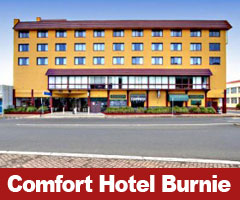Situated on Emu Bay at the mouth of the Emu River, Burnie is Tasmania's third largest city and port for the rich agricultural and mineral mining activities of the region. Burnie is a major deepwater port for the north of Tasmania, with two permanent container ships making daily crossings to Melbourne. Burnie is very much a city in transition. Driven by the need to renew its economic base after the closure of major industrial workd, it is actively campaigning to bolster tourism, attract new investment and build the capacity of residents to develop businesses of their own. This move is appropriate and timely as Burnie makes a great base for exploring the region due to its central position and extensive facilties.
Best Time To Go
November to April is the peak season in Tasmania. Summer brings warm days and mild evenings from December to February, while winter can be stormy with snow on the mountain peaks between July and August. Rainfall occurs throughout the year. The weather is most stable from the end of summer to autumn (February to May). Many towns in the region are planted with European deciduous trees which shed their leaves in Autumn (March to May). Their display of red and golden make the region particularly picturesque during these months.

Where Is it?
Burnie is 149 km north west of Launcestion via Bass Highway, 47 km west of Devonport. It is a sea port on Bass Strait
How To Get There?
By car, from Melbourne, take the Spirit of Tasmania car and
passenger ferry overnight from Melbourne. A supplementary day travel
services operates during summer months. drive from Devonport to Burnie.
From Launceston: drive to Burnie via Deloraine, taking Bass Highway via Midland Highway south from Launceston.
From Hobart: drive north via Midland Highway, following the signs to
Devonport and Burnie before reaching Launceston. By coach, Tassielink
Coaches services all major centres throughout Tasmania. Bus service
Metro Tasmania provides bus transport around the city and its suburbs.
Burnie Airport is a 20 minute drive from the City of Burnie and is the
closest Tasmanian mainland facility serviced daily from Melbourne.
Burnie Port is Tasmania’s largest general cargo port and
Australia’s largest container port. It is the nearest Tasmanian
port to Melbourne.
Visitor Information Centre
Makers' Workshop, 2 Bass Hwy, Burnie. Ph (03) 6430 5831

Things To See And Do

Burnie Regional Museum
Burnie Regional Museum provides a detailed account of the history of the city of Burnie. Wander the charming Federation Street and see how ordinary people lived 100 years ago. The Museum has a beautiful range of vintage and antique-inspired gifts, quality educational gifts for children, Tasmanian history books and historical novels and souvenirs. You can also purchase reprints of historical photographs from our collection.

Makers' Workshop
There are not too many places in Australia - or the world for that matter - that offer the visitor something so unique you will be hard pressed to find anything like it elsewhere. The City of Burnie has managed to achieve this in its newest visitor attraction - Makers' Workshop. Drawing on the city’s heritage as a leading industrial centre, Makers’ Workshop salutes the role of paper manufacturing in its past, while honouring the skills of its makers, innovators and artists of its present and future.

Burnie Regional Art Gallery
Serving the north-west and west coasts of Tasmania, the Gallery has
a fine permanent collection, and the focus is on works on paper,
including many fine prints by some of Australia’s most famous
artists. This reflects the importance of the paper industry in
Burnie’s past history.
Location: Burnie Arts & Function Centre, Wilmot St, Burnie

Surrounding Area

Coastal Drive
A day drive from Burnie up the north west coast is highly recommended. The drive can include Wynyard, Table Cape, picturesque village of Boat Harbour, Stanley and Circular Head, Rocky Cape National Park, Smithton, and Marrawah on the west coast. Simply follow Bass Highway west from Burnie. Off the main road you will find Trowutta caves and arch; Hellyer Gorge State Reserve; Allendale Gardens at Edith Creek. The coastal towns of Ulverstone (16km) and Penguin (28km) are to the east of Burnie on the road to Devonport. There are numerous waterfalls to visit, including Dip Falls and the giant eucalyptus tree and Guide Falls. Another recommended day trip from Burnie is a driving tour of the Great Western Tiers.

Cradle Mountain Lake St Clair National Park
Cradle Mountain Lake St Clair National Park is around a 1hour 30 minute drive south west of Devonport. Australia's most recognisable mountain, Cradle Mountain forms the northern end of the wild Cradle Mtn. Lake St Clair National Park, itself a part of the Tasmanian Wilderness World Heritage Area. The familiar jagged contours of Cradle Mountain epitomise the feel of a wild landscape, while abundant wildlife, icy streams, alpine heathlands, colourful deciduous beech and ancient pines reflected in still glacial lakes entice many visitors to stay and explore.
Emu Valley Rhododendron Garden
Emu Valley Rhododendron Garden has about 20,000 plants on an 11ha landscaped site just 8km south of Burnie.





